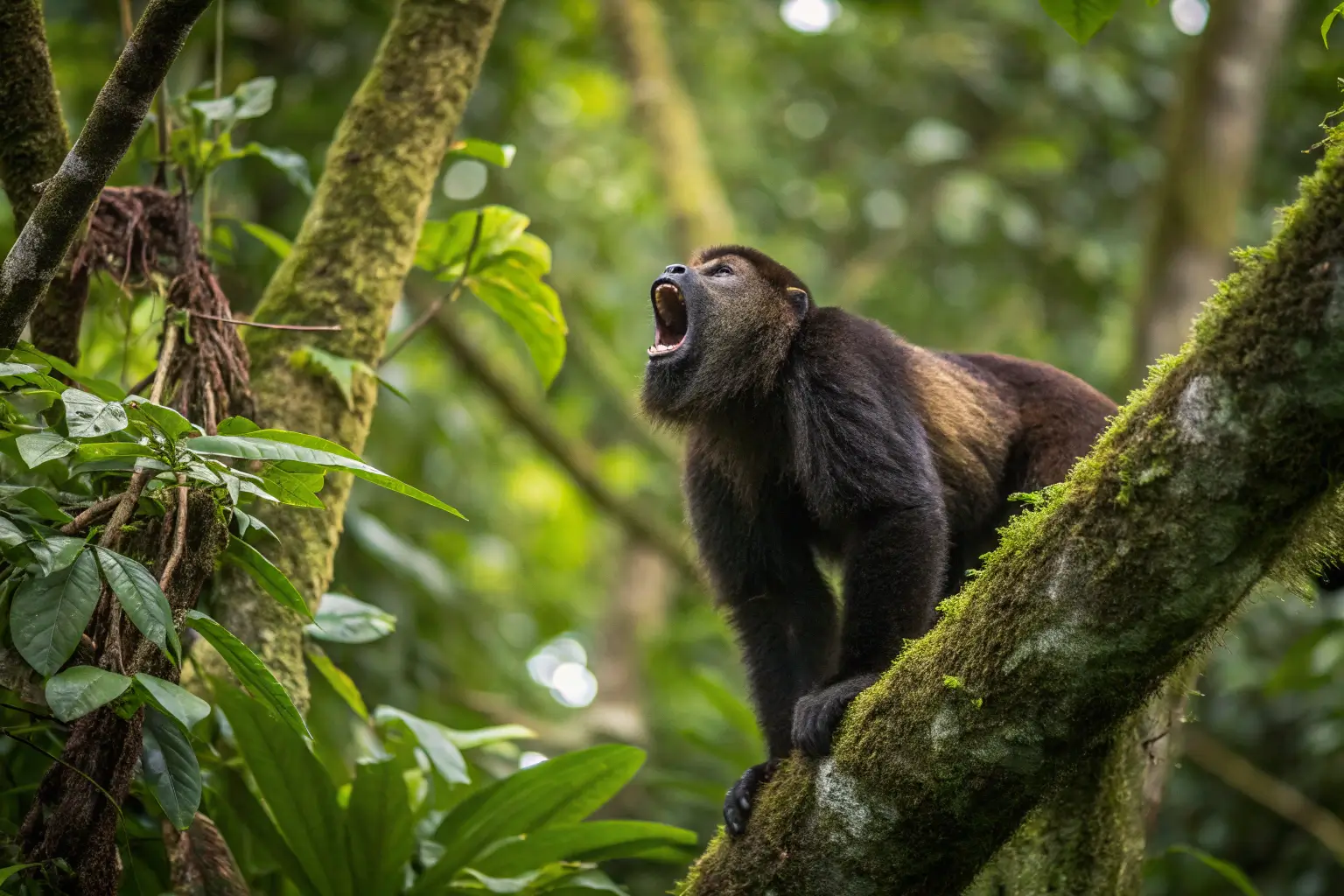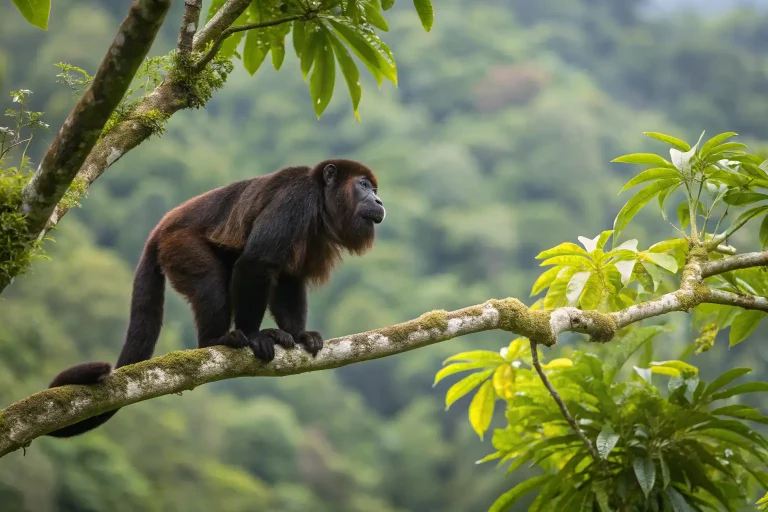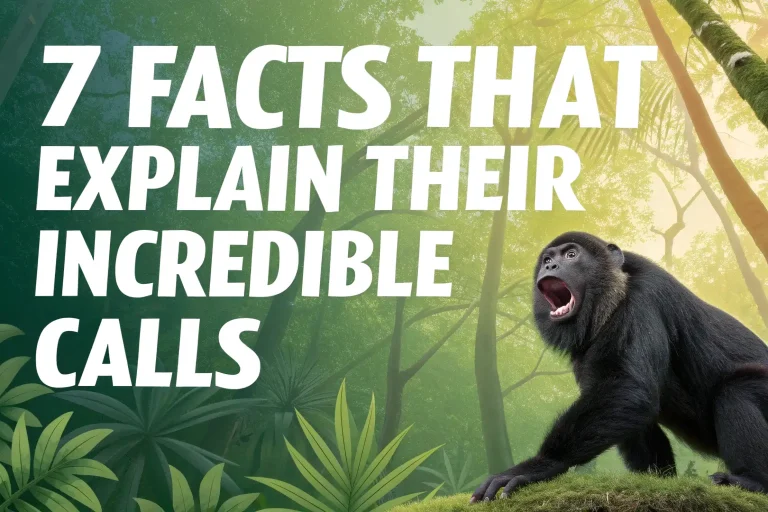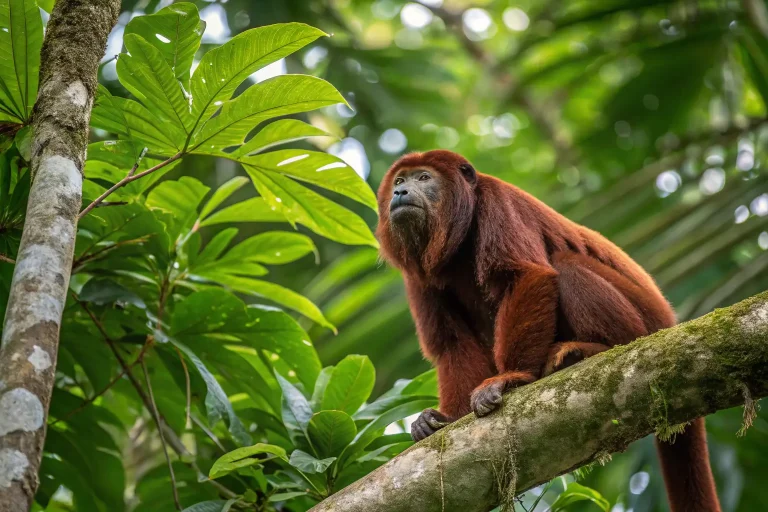Howler Monkey Sounds: 7 Astonishing Facts You Need to Hear!
Ever wondered why howler monkey sounds are so loud? Uncover 7 surprising facts that’ll change how you hear these primates. Dive into their world! Discover more.
Introduction
The dense canopy of Central and South American rainforests occasionally erupts with what might be the most extraordinary sound in the animal kingdom. If you’ve ever had the privilege—or perhaps the startling experience—of hearing howler monkey sounds in person, you understand why these remarkable primates earned their name. Their bellowing calls can travel for miles through dense jungle, resonating with such impressive volume that early explorers often described them as “forest demons” or believed much larger creatures must be making such thunderous noise.
Learning about howler monkeys and their distinctive vocalizations isn’t just fascinating—it provides crucial insights into primate communication, rainforest ecosystems, and even evolutionary biology. These incredible animals serve as indicator species for forest health while their complex social structures reveal surprising parallels to human social dynamics.
And here’s something most people don’t realize: those earth-shaking howler monkey sounds you hear in movies to establish a jungle setting? Directors often amplify real howler calls because audiences wouldn’t believe the authentic volume these 15-pound primates can actually produce!
Species Overview
Scientific Name
Howler monkeys belong to the genus Alouatta within the family Atelidae. There are currently 15 recognized species of howler monkeys, including the most commonly known mantled howler (Alouatta palliata), the red howler (Alouatta seniculus), and the black howler (Alouatta caraya).
Physical Characteristics
Weighing between 10-22 pounds (4.5-10 kg), howler monkeys aren’t the largest primates, but they possess unique anatomical structures that enable their remarkable vocalizations. Their most distinctive feature is an enlarged hyoid bone—a specialized throat structure that functions essentially as a natural amplification chamber. This adaptation creates a resonating chamber that transforms their relatively small bodies into living loudspeakers.
Howlers display pronounced sexual dimorphism, with males typically larger than females. Their coats vary dramatically by species, ranging from golden and reddish hues to deep blacks. But what truly sets them apart is their powerful prehensile tail—essentially a fifth limb that can support their entire body weight while hanging from branches.
Subspecies
The mantled howler monkey (A. palliata) has five recognized subspecies distributed across different regions of Central America, each with subtle variations in appearance and vocalization patterns. The Mexican howler (A. palliata mexicana) displays slightly deeper calls than its southern cousins, while the Ecuadorian mantled howler (A. palliata aequatorialis) exhibits distinctions in its morning chorus timing that researchers believe relate to territorial boundaries.
Habitat and Distribution
Natural Habitat
Howler monkeys thrive primarily in tropical rainforests with continuous, dense canopies. Their preference for the upper canopy layers—typically 25-30 meters above ground—keeps them safely away from most predators while providing access to their preferred young leaves, fruits, and flowers. Their remarkable vocal abilities evolved partly in response to these dense forest environments, where visual communication across distances presents significant challenges.
Geographic Range
From southern Mexico through Central America and into the northern portions of South America, different howler monkey species have adapted to various forest ecosystems. The mantled howler spreads through Central American rainforests, while the red howler extends through the Amazon Basin. The black howler, interestingly, can be found as far south as Argentina, demonstrating the genus’s impressive adaptability to different forest types.
Adaptations
Beyond their extraordinary vocal equipment, howler monkeys have developed specialized adaptations to their arboreal lifestyle. Their digestive systems contain bacteria that help break down the complex cellulose in leaves—an important adaptation since leaves comprise up to 70% of their diet. This ability to consume leaves—a readily available but difficult-to-digest food source—reduces competition with other primates who cannot process them efficiently.
Their slow, deliberate movements conserve energy, essential for animals whose leaf-heavy diet provides relatively little caloric return. This energy conservation strategy complements their incredible vocalizations, which allow them to establish and defend territory without expending energy on physical confrontations.
Diet and Feeding Habits
What It Eats
Howler monkeys are primarily folivores (leaf-eaters), though they supplement their diet with fruits, flowers, and occasionally nuts. Their preference for young, tender leaves relates directly to their digestive capabilities, as these contain fewer toxins and are easier to break down. Interestingly, the mechanics of their distinctive howler monkey sounds may have co-evolved with their dietary adaptations—their enlarged hyoid bone creates space limitations that affected jaw muscle development, influencing their chewing capabilities.
Hunting or Foraging Behavior
Rather than actively hunting, howlers employ a strategic foraging approach. Troops typically move slowly through their territory, carefully selecting feeding trees based on leaf quality, fruit availability, and nutritional needs. Research shows they often return to the same feeding trees on roughly 2-3 week cycles, allowing sufficient time for new growth before returning—a sustainable foraging strategy that prevents resource depletion.
Dietary Needs
A howler monkey’s leaf-based diet necessitates careful nutritional balancing. They selectively choose leaves with higher protein content and fewer defensive toxins. Studies measuring howler monkey sounds have identified specific calls that apparently communicate food quality to others in their troop—with distinctive vocalizations used when discovering particularly nutritious food sources.
Behavior and Social Structure
Social Behavior
Howler monkeys live in troops ranging from 5 to 20 individuals, typically consisting of a dominant male, several females, and their offspring. Some species form multi-male troops, suggesting adaptive flexibility based on environmental conditions. What makes their social structure particularly fascinating is the acoustic coordination of group behavior—howler monkey sounds serve as complex social glue that maintains group cohesion without requiring constant visual contact in dense foliage.
Communication
Perhaps unsurprisingly, vocalizations form the cornerstone of howler monkey communication. Their signature howls—reaching an incredible 140 decibels at close range—serve multiple purposes: establishing territorial boundaries, communicating with distant troops, coordinating group movements, and attracting mates.
Dawn chorus howling typically begins just before sunrise when dominant males initiate calls that cascade through the troop. These performances last 30-45 minutes and can include distinctive individual variations—researchers have identified “vocal fingerprints” unique to specific monkeys. Beyond their famous howls, they employ a rich vocabulary of softer grunts, barks, and whimpers for close-range communication within the troop.
Mating and Reproduction
Mating patterns vary by species, but most howlers are polygynous, with dominant males securing mating access to multiple females. Female howlers typically give birth to a single infant after a roughly six-month gestation period. Interestingly, researchers have documented distinctive howler monkey sounds made by males during female ovulation periods—specialized calls apparently advertising reproductive fitness.
Infants cling to their mothers for the first few months of life before gradually gaining independence. Young males eventually leave their birth troops upon reaching sexual maturity, while females often remain with their natal group—a pattern that helps prevent inbreeding.
Conservation Status
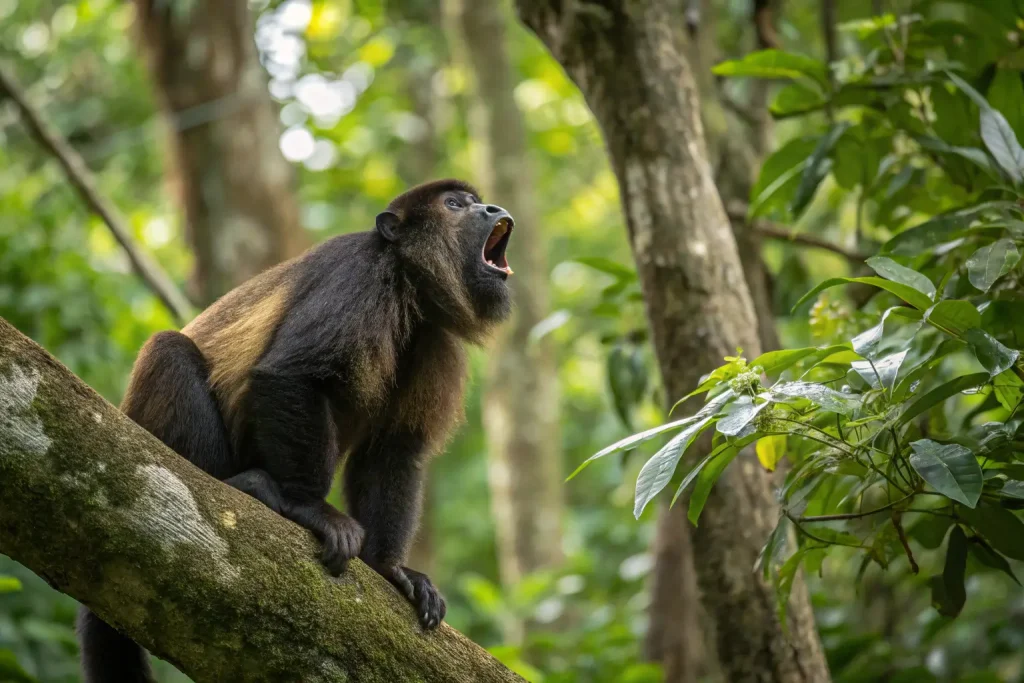
Endangerment Level
Conservation status varies significantly by species. According to the IUCN Red List, the Guatemalan black howler (A. pigra) and the brown howler (A. guariba) are listed as Endangered, while others like the mantled howler are classified as Least Concern. Overall trends remain concerning, with most populations declining due to habitat pressures.
Threats
Deforestation represents the most significant threat to howler monkey populations. Their specialized arboreal lifestyle makes them particularly vulnerable to forest fragmentation. When forests are converted to agricultural land or urban development, howler populations become isolated in forest fragments that can’t support viable populations long-term.
Climate change poses an emerging threat, as changing rainfall patterns affect leaf quality and fruit production. Additionally, howler monkeys are susceptible to yellow fever, and outbreaks have caused devastating population crashes in some regions.
Conservation Efforts
Several dedicated conservation programs focus specifically on howler monkeys. The Howler Monkey Reintroduction Program in Belize has successfully reintroduced troops into protected forest reserves. Community-based initiatives across Central America combine howler monkey protection with sustainable development projects that benefit local communities.
Acoustic monitoring programs utilize recording technology to track howler monkey sounds across forest landscapes, allowing researchers to monitor population trends without direct observation—an efficient conservation tool for these vocal primates.
Interesting Facts
Volume Champions: Howler monkey sounds rank among the loudest animal calls on Earth, reaching up to 140 decibels—comparable to a jet engine at close range. They hold the Guinness World Record for loudest land animal.
Survival Strategy: Their powerful vocalizations evolved as an energy-efficient alternative to physical confrontations. By establishing territory through sound rather than fighting, howlers conserve precious energy.
Natural Barometers: Local indigenous communities have long used howler monkey calling patterns to predict weather changes. Recent research confirms howlers modify their calling behavior before storms, potentially sensing barometric pressure changes.
Sound Specialists: Male howlers have larger hyoid bones than females, creating deeper, more resonant calls. The trade-off? Their larger vocal apparatus leaves less room for other throat structures, resulting in smaller teeth and jaws.
Cinema Stars: Those iconic jungle sounds in films from “Raiders of the Lost Ark” to “Jurassic Park” often incorporate modified howler monkey calls. Sound designers frequently layer their vocalizations to create immersive jungle atmospheres.
Color-Changing Capability: Black howler monkey males are born with golden fur that gradually darkens to black with maturity—one of the few mammals that change coat color as they age.
Rainforest Gardeners: Howler monkeys serve as important seed dispersers in tropical forests. Seeds that pass through their digestive systems germinate more successfully than undispersed seeds, making howlers critical for forest regeneration.
Tips for Caring for the Animal
While howler monkeys are not appropriate pets due to their specialized needs, complex social requirements, and protected status, understanding these magnificent creatures can enhance wildlife tourism experiences in their native habitats.
For wildlife enthusiasts hoping to observe howler monkeys in sanctuaries or rehabilitation centers:
- Distance Respect: Always maintain appropriate distance—even sanctuary howlers retain wild instincts and can become stressed by close human proximity.
- Sound Awareness: Be prepared for their incredible vocalizations, which can be startling when experienced in person. Early morning visits often provide the best opportunity to hear howler monkey sounds during their dawn chorus.
- Photography Tips: Bring a zoom lens, as howlers typically remain high in the canopy. Morning light often illuminates them beautifully against foliage.
- Support Organizations: Consider supporting reputable primate sanctuaries that rehabilitate howlers affected by habitat loss or illegal wildlife trade.
Role in the Ecosystem
Ecological Importance
Howler monkeys serve as keystone species in tropical ecosystems. As primary consumers of leaves and fruits, they process large quantities of plant material, recycling nutrients through their digestive systems. Their selective feeding habits influence forest composition by affecting seed dispersal patterns and plant reproductive success.
The distinctive howler monkey sounds also create what scientists call an “acoustic niche” in the forest—their vocalizations have shaped how other species communicate, with birds, insects, and other mammals evolving calls that don’t compete in the same frequency ranges.
Impact of Decline
The loss of howler monkeys from forest ecosystems creates cascading effects. Without their seed dispersal services, certain plant species show reduced recruitment and altered distribution patterns. Research in forest fragments where howlers have disappeared shows measurable changes in seedling composition and reduced forest regeneration rates.
Their absence also disrupts predator-prey relationships, as howlers represent important prey for harpy eagles, jaguars, and large snakes. The silence left when howler monkey sounds vanish from a forest often signals broader ecological disruption in progress.
Conclusion
The extraordinary power and complexity of howler monkey sounds represent far more than just an impressive natural phenomenon—they open windows into the evolutionary history of communication, the intricate relationships within rainforest ecosystems, and the remarkable adaptations that allow species to thrive in specialized niches.
As we continue facing unprecedented biodiversity losses worldwide, the distinctive calls of howler monkeys serve as powerful reminders of what’s at stake. Each forest that falls silent represents not just the loss of these magnificent primates but the unraveling of complex ecological relationships developed over millions of years.
By protecting howler monkey habitats, supporting conservation initiatives, and better understanding these remarkable vocal specialists, we help preserve not just a single species but entire functioning ecosystems. The next time you hear those distinctive howler monkey sounds—whether in a nature documentary or, if you’re fortunate, in person—remember you’re experiencing one of nature’s most extraordinary acoustic achievements and a vital component of tropical forest health.
Frequently Asked Questions
How loud are howler monkey sounds compared to other animals?
Howler monkeys produce calls reaching up to 140 decibels, making them the loudest land animals on Earth. For comparison, a lion’s roar typically reaches about 114 decibels, while a wolf’s howl measures around 90 decibels. The only animals that regularly produce louder sounds are certain whales, whose calls can exceed 180 decibels underwater.
Why do howler monkeys make such loud sounds?
Their extraordinary vocalizations evolved primarily for territorial communication across dense forests where visual cues are limited. The calls help maintain spacing between troops without physical confrontation, coordinate group movements, attract mates, and warn of predators. This acoustic strategy conserves energy compared to physical territorial defense.
What time of day are howler monkeys most vocal?
Howlers typically vocalize most intensely during dawn and dusk periods, with the dawn chorus representing their most reliable and consistent calling pattern. The early morning calls often begin 30-45 minutes before sunrise and can continue for up to an hour. Occasional calling may occur throughout the day, especially in response to disturbances or territorial challenges.
Can howler monkeys really be heard from 3 miles away?
Yes! Under favorable atmospheric conditions, howler monkey sounds can carry up to 3-5 kilometers (approximately 2-3 miles) through dense forest. This remarkable projection capability comes from their specialized hyoid bone, which creates a resonance chamber that amplifies their calls to extraordinary distances despite their relatively small body size.
Are howler monkeys dangerous to humans?
Howler monkeys pose virtually no threat to humans. Despite their intimidating vocalizations, they’re generally shy, non-aggressive primates that avoid human contact whenever possible. They lack both the size and temperament for confrontation with humans, preferring to retreat higher into the canopy when disturbed rather than engage.
How long do howler monkeys live?
In the wild, howler monkeys typically live 15-20 years, though some individuals may reach 25 years under optimal conditions. In captivity, with regular veterinary care and absence of predators, they can occasionally live into their late 20s, with the oldest recorded captive howler reaching 30 years.
What’s the difference between a howler monkey and a regular monkey?
Howler monkeys differ from other monkeys primarily through their specialized anatomy for vocalization (enlarged hyoid bone), their primarily leaf-based diet, and their prehensile tails that function as a fifth limb. While many monkey species are highly active and fast-moving, howlers exhibit relatively slow, deliberate movements to conserve energy—an adaptation to their less calorie-dense leaf diet.

